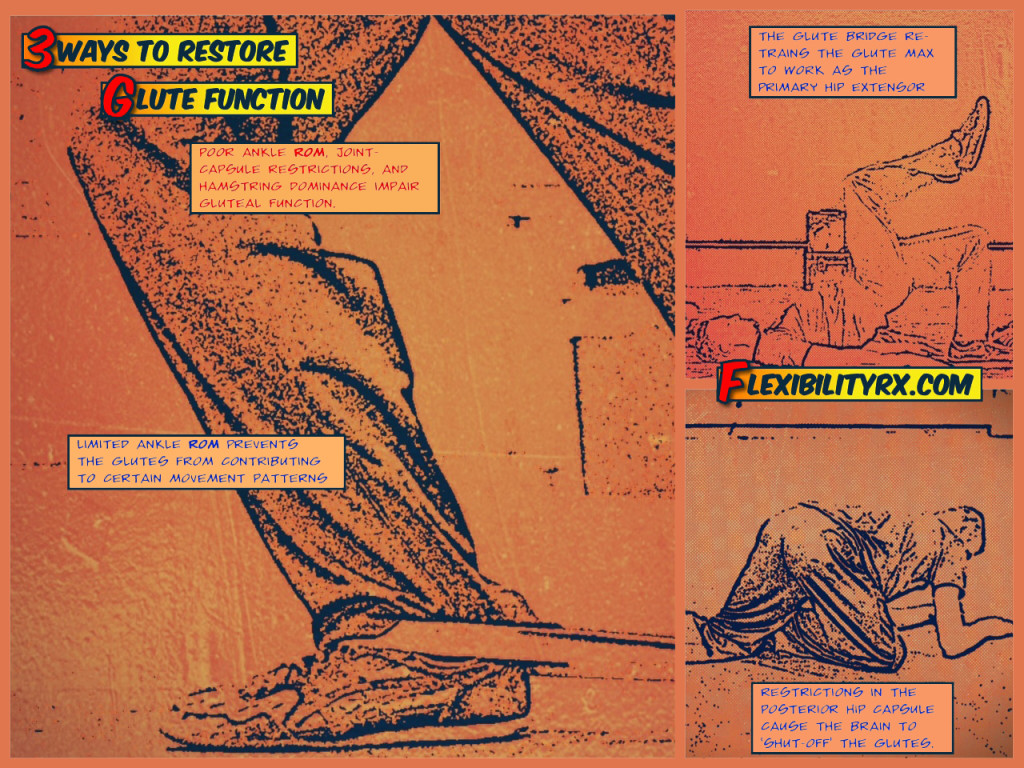
Glute Activation Drills
Glute Activation: Fixing Gluteal Imbalances
Many athletes have tight hip-flexors whether it’s from prolonged sitting, pelvic imbalances, or favoring one leg while playing a sport. When the deep hip flexor (psoas) is overactive/tight it inhibits the primary hip extensor (glute max) and forces the low-back and hamstrings to overwork during squats and deadlifts. This can lead to low-back pain and chronic hamstring tightness – sound familiar?
This can be remedied by stretching your hip-flexors, and activating the glutes with loaded hip dominant exercises like barbell hip-thrusts, good mornings, and deadlifts.
Here are three other reasons you may have glute impairments or hip dysfunction…
#1: Limited Ankle Range of Motion
Ankle flexibility is crucial to running, lunging, and squatting. Limited ankle range of motion can impair glute function – robbing the hips of their power – during certain athletic movements. An athlete that has poor ankle flexibility will have achieving full squat depth, keeping the knees out, and maintaining an upright torso.
“If you use dorsiflexion in a level change like a squat and lunge, as the ankle starts to run out of room, good freedom in the ankle allows for a posterior weight shift. So when the person is “allowed” to continue to sit back, the glutes are in a line of pull to continue that natural level change or pattern…
When there is an anterior weight shift, there is bony approximation and protective tone which leaves no “need” for the glutes to be as involved in stabilizing the pattern.” – Charlie Weingroff
#2: Joint-Capsule
Fifty percent of range of motion is in the joint-capsule itself. A tight posterior hip capsule not only limits range of motion (hip internal/external rotation) but also signals the brain to down-regulate glute activity. In other words, your glutes aren’t firing because of tightness in the joint-capsule itself. Stretching your glutes can help, but the deeper joint-capsule restriction needs to be addressed.
#3: Hamstring Dominance
The glute max is the primary hip extensor and is assisted by the hamstrings to lock out the hips during the completion of the deadlift and ascending part of the squat.
Many athletes have inhibited glutes and overactive hamstrings. This pattern causes the hamstrings to drive the head of the femur forward in the hip socket – compromising stability. The glute bridge retrains the glute max to control the femur during hip extension while inhibiting the deep hip flexor (psoas).
Kevin Kula, “The Flexibility Coach” – Creator of FlexibilityRx™ – www.FlexibilityRx.com
Related Resources
FlexibilityRx: Hip Flexor Stretch for Tight Hips (link)
Bret Contreras: How to Fix Glute Imbalances (link)
Bret Contreras: How to Hip Thrust (link)
Charlie Weingroff: Ankle Dorsiflexion and Glute Activation (link)

Leave A Reply (No comments so far)
You must be logged in to post a comment.
No comments yet